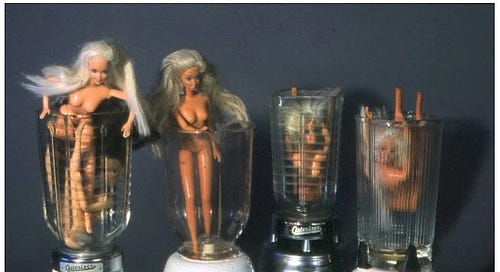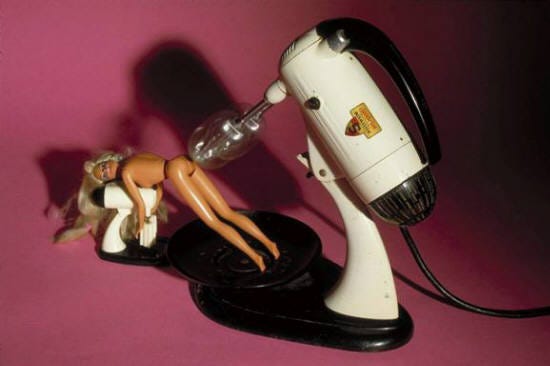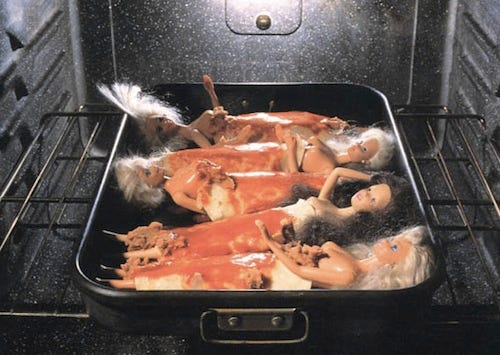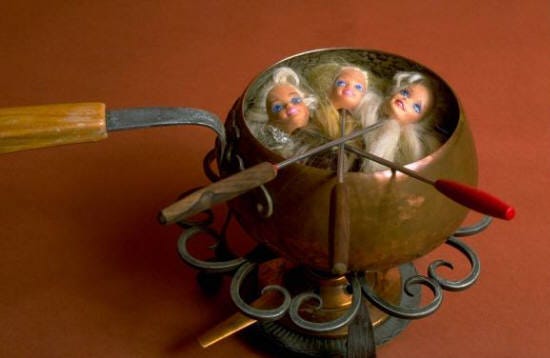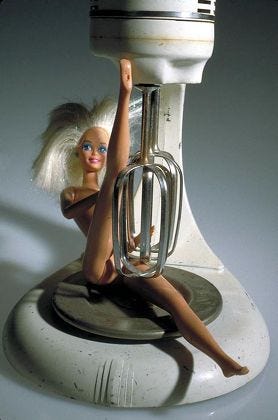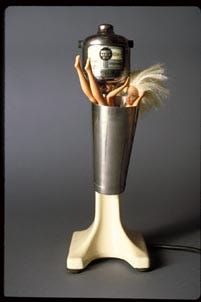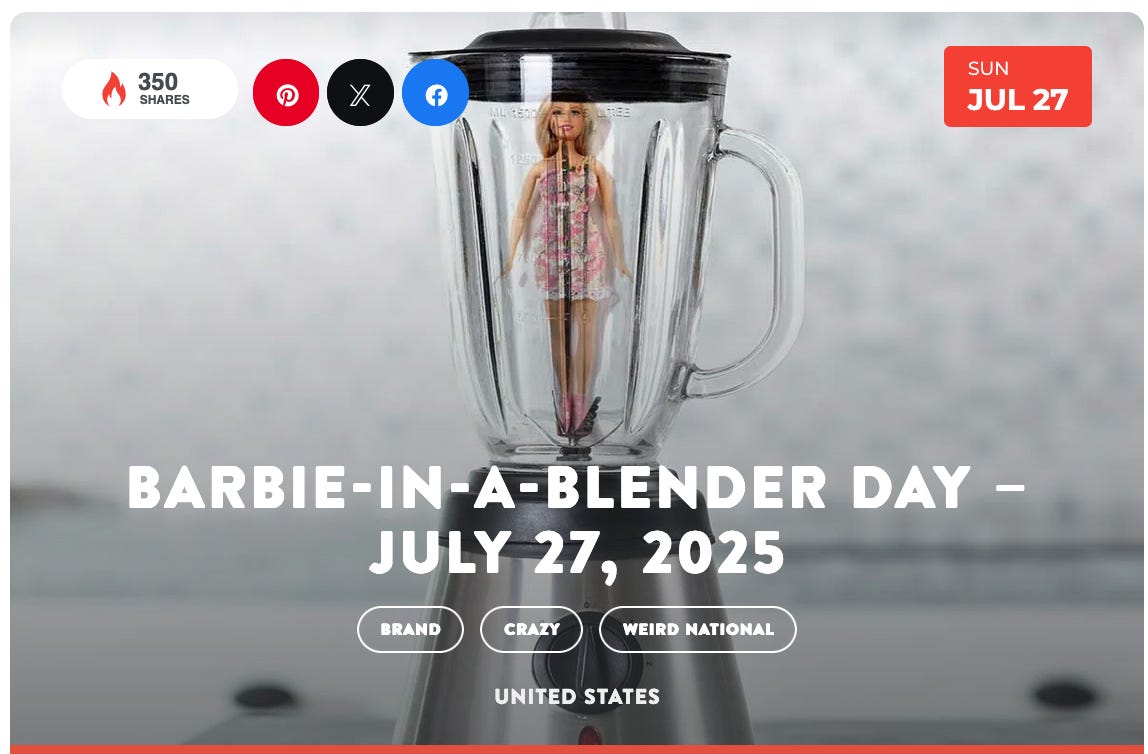In 1997, artist Tom Forsythe, created a series of photographs called “Food Chain Barbie.” This collection of 78 photos led him to a lawsuit against Mattel. He won the case in 2004.
“From what I've learned in the course of defending my very basic free speech rights, this is a fairly standard cost of fighting a legal battle in federal court. It only confirms what I've always sensed, that the legal system is little more than a boxing ring for the rich with the common people not even invited to experience the proceedings on pay per view. We may be free to express ourselves, but if that expression involves offending a rapacious corporation, they're equally free to sue; and unless we have the wherewithal to fight off high powered attorneys, that's where our free speech ends.” (NCAC)
The Barbie dolls were typically naked, some dismembered in some way. They were placed in various kitchen appliances, blenders, fondue pots, ovens, and more. The intent was to create a visual for how women are shaped and consumed by societal expectations.
The art wasn’t about harming women, it’s intent was to show how consumer culture is actively harming women.
Barbie always remains pleasant with a smiling expression on her face no matter what pressure they’re under or what job they’re taking on. By putting Barbie inside these vintage appliances, Forsythe was using satire to poke at the nature of women’s traditional roles.
I grew up hearing that women belong in the kitchen. What is and isn’t ladylike, complaining is not ladylike by the way.
“In some of Forsythe’s photos, Barbie is about to be destroyed or harmed by domestic life in the form of kitchen appliances, yet continues displaying her well-known smile, disturbingly oblivious to her predicament,” the court observed. “It is not difficult to see the commentary that Forsythe intended or the harm that he perceived in Barbie’s influence on gender roles and the position of women in society.” (ABA Journal)
I also grew up with the message that I could be whatever I wanted to be. But first, I must be a proper lady.
Women before me had already fought and won our rights to be equal to men in society, there weren’t any existing barriers or need to discuss the intersectionality of those claims, we were in an equal society and anyone who says differently is an angry ungrateful woman, again not lady like at all.
Women could have it all, beauty, career, motherhood. No one warned me of the cost of attempting to live up to the expectation of actually trying to live like Barbie.
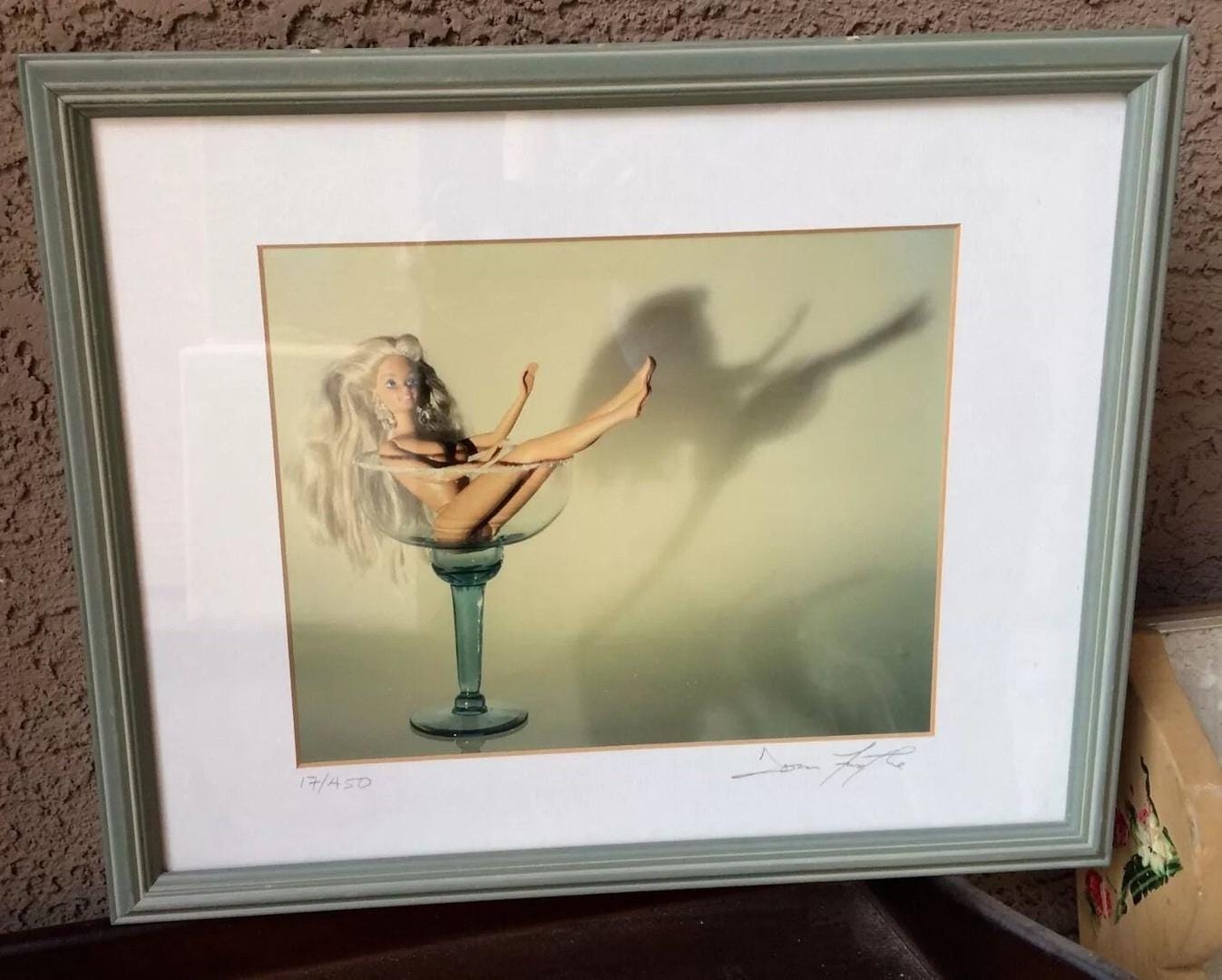
In the same way, the doll retains its glazed, blissful smile regardless of its impending fate. While most of us at least start to grimace when we smell the heating oil that signals our demise, Barbie keeps a happy face courtesy of the image-makers who hope beyond hope that those of us on the receiving end will continue to do the same. (NCAC)
Barbie has every career imaginable, always with ease and a smile, but also always enforcing conformity and femininity only in ways that were still “respected” under the patriarchy.
Forsythe took that myth and literally shoved it in a blender. It was a critique of consumerism, gender stereotypes, the corporatization of beauty & domesticity, as well as the underlying violence of “idealized” femininity. Barbie is mutilated to expose feminine ideals as hollow, oppressive symbols.
“I used Barbie because she’s the most powerful visual symbol of gendered expectations. And I used kitchen appliances because they’re the tools of that gendered system.”
In Jungian terms, she’s a distorted anima archetype.
Barbie is the "feminine" ideal projected onto society, now mass-produced and sold. Forsythe made her the offering and not just the woman using the tools. He was showing what happens to both women and our cultural ideals when they’re seen as products for consumption.
What I find most interesting is how his challenge to how women are treated, ended up challenging his own artistic range. As I mentioned earlier, he was sued and ended up winning the case thanks to the SoCal ACLU taking on his case.
At the time of trial he had only earned $3,659 in revenue from the collection. It was revealed during the trial that "at least of half" of this money came from Mattel investigators who bought the pictures in order to make their case.
"This ruling shows that might is not always right," said artist Tom Forsythe. "The judge's decision is a powerful victory for all feminists who criticize Barbie's stereotype of women and the unquestioning acceptance that allows Mattel to sell these hyper-sexualized hunks of plastic into millions of American homes." (ACLU)
It would be nice if I could wrap this up and say this all stayed in the 1990’s and early-2000’s. But I’m writing this as free speech is under new pressure in ways that are quieter and more insidious.
I’m watching trends slide into conservatism, the rise of tradwives. Consumer protections being stripped away giving corporations more power than any other time in history. The corporate control Forsythe was up against hasn’t gone away. It’s just gotten smarter. It’s baked into every layer of culture now, from the media we consume to the language we’re allowed to use.
The lawsuit would go on to be acclaimed as a defining triumph for artistic freedom of speech and pro-consumer brand critiquing, one that would later manifest itself in the form of an obscure national holiday established by the Students For a Free Culture organization, known then as Freeculture.org. (KFOR)
There’s a huge push to sanitize everything again, to make femininity safe, to make gender roles comfortable and familiar. We’re told this is about tradition or wholesomeness, but what it really is is control.
That’s the same performance Barbie was doing in Forsythe’s photos. Smiling as she’s being consumed. Smiling as she’s mutilated and boiled and folded into domesticity. It’s a mirror.
I didn’t see this when I was a kid, still playing with Barbies and taking in the Fairytale stories about what my future should look like. I see it now.
National Barbie-in-a-Blender Day is coming up next month (July 27), and I think we should make it a point to celebrate.
It started because one artist had a point to make and refused to stay quiet, fighting back when a corporation tried to shut him down. This day now stands as a reminder of the power of critique and the importance of protecting the right to speak up.
Critique has always come with risk, and that risk hasn’t gone anywhere. The pressure to stay quiet, to stay agreeable, to stay in your place is still present. We have to continue to call out the ways gender, beauty, and identity get packaged and sold back to us.
Links used when creating this yap-fest:
Tom Forsythe’s Food Chain Barbie
Food Chain Barbie & the Fight for Free Speech
Meet Lawsuit Barbie: She's been busy at Barbie's courthouse
SIGNIFICANCE: MATTEL, INC. V. WALKING MOUNTAIN PRODUCTIONS
When Is A Parody Protected By Fair Use
How fair use brought us VCRs, copiers—and nude Barbie enchiladas
Barbie is enjoying a resurgence. So why are some people putting the dolls in blenders?


